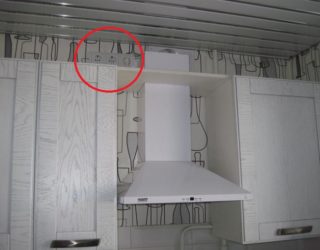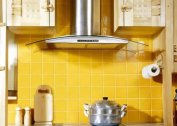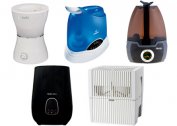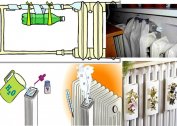When installing the hood in the kitchen, along with the selection of a suitable place for it, the issue of connecting to a household electrical network is solved. The easiest way to do this is with a typical installation product - a separate outlet, located in a predetermined place for this. The outlet for the hood should be positioned so as not to interfere with the installation of wall cabinets and other samples of kitchen equipment. In addition, it is not recommended to mount it too close to their walls.
Types of hoods and their features when connected to the mains
From the point of view of connecting to a household electric network, the hood models presented on the domestic market differ in the following ways:
- constructive design;
- installation method;
- power consumed by the unit from the network.
According to the first feature, cooker hoods are domed, with inclined planes or horizontal. Most of the known designs do not interfere with the installation of the power outlet. According to the second criterion, the choice of options is also diverse. The devices have the following versions:
- outboard;
- built in a wall cabinet;
- wall mounted;
- angular and island.
Most modern cooker hoods are somehow connected with a hinged kitchen cabinet located above the hob, or simply hung as an independent structure.
The socket for a built-in hood in the kitchen is most conveniently placed in a wall cabinet or directly above its top panel. If there is a wall-mounted exhaust unit in the kitchen room, it is installed in the duct casing. The best option for the location of the electrical outlet is at a height of 110 cm from the countertop of the kitchen unit. In this case, the installation location is suitable for almost any model of exhaust devices. The choice of the type of outlet product and the power cable for its connection depends on the power of the model mounted in the kitchen.
Socket and cable selection
If a separate outlet is provided for the hood in the kitchen, its choice depends on the electrical power consumed by the device from the home network. For most modern models, this indicator does not exceed 1.0 kW, which allows you to install a typical product, designed for a current of up to 10 Amps.
With large values of power consumption, it is possible to install a special power outlet that can withstand significant currents (up to 25 Amps). In this case, it will require laying a separate power cable with the following technical indicators:
- wire brand: VVG or similar;
- the number of copper cores - 3 or 4;
- section - not less than 2.5 mm square.
Such a socket and cable are connected through a protective circuit breaker installed in the control cabinet, designed for a cut-off current of 25 Amps.
Seat selection
If you decide to make a separate outlet for a cooker hood, you need to choose the right place for this. The following criteria are taken into account:
- product compliance with regulatory requirements (PUE);
- ease of use;
- the possibility of hanging other items of furniture;
- compliance with the interior of the kitchen.
Particular attention is paid to the height of the outlet in the kitchen, which according to the requirements of the PUE must be at least 1.0 meters from the floor. When it is located in the upper part of the wall plane with the same positions, it is not allowed to approach the ceiling closer than 10 centimeters.
If there is a large amount of furniture, the installation location is selected based on the possibility of free installation and ease of connection.
Installation methods
There are several options for installing an outlet under a cooker hood. They are distinguished by the following criteria:
- for built-in modifications of exhaust devices;
- for samples of hood type hoods;
- if possible, install the outlet in a protective casing.
In the first case, the outlet for the built-in hood is most conveniently located inside the wall cabinet itself. For suspended models, the area above the upper panel, located near the duct, is optimally suited. In this case, the power cord is securely hidden behind the structure and does not spoil the overall appearance of the kitchen. The last of the proposed options is good in itself, since the outlet is reliably hidden, its location does not violate any of the requirements of current standards.
The standard length of the electric cord for the hoods rarely exceeds 80 cm, which must be taken into account when choosing a convenient place. At the wiring stage, you will need to prepare a clear plan of the kitchen with the indicated areas for the location of the gas stove and home wiring in order to accurately determine the place that is optimal for installing a power outlet.
Connection options
It is allowed to connect the hood in the apartment through an outlet or directly to the distribution panel (circuit breaker installed in it). The benefit of the latter switching method is as follows:
- the number of connecting contacts and wires is reduced, the reliability of the operation of the supply line is increased;
- expenses for the purchase of installation products are reduced - you do not need to purchase a separate outlet with all its fasteners;
- no need to select a place for the outlet.
The disadvantage of this connection option is the ability to turn off the hood only using protective AB, located at a considerable distance from the kitchen.
The advantage of the first connection method is the convenience of switching the exhaust unit (the socket is always at hand) and saving space in the distribution panel. Its disadvantage is the need to allocate a special place and the cost of arranging the outlet with local grounding.
Electrical safety and quick disconnect
Since the cooker hood and stove are made of conductive material, the presence of a power outlet nearby is dangerous for the user. In the event of accidental damage to the insulation of the mounting wires, voltage hazardous to humans may be on the hood or stove body. For this reason, in accordance with current standards and safety requirements, the electrical outlet itself and the housings of stoves and hoods must be reliably protected. To do this, you need to connect the conductive parts of the equipment with a grounding device specially equipped in the house or apartment. For this purpose, the kitchen outlet must have a separate terminal designed specifically for the designated purpose. For quick shutdown in an emergency, it must be placed away from the protruding parts of the equipment.







